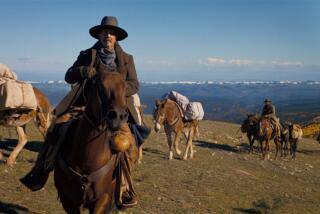Crazy Quilt
Philip Kimball’s enigmatic new novel, “Liar’s Moon,” begins with a quotation from the most debated of all American historical essays, Frederick Jackson Turner’s “The Significance of the Frontier in American History.” Delivered in Chicago at the Columbian Exposition of 1893, Turner’s thesis proclaimed the closing of the frontier as well as its indelible stamp on the American character. “In spite of environment,” wrote Turner, “and in spite of custom, each frontier did indeed furnish a new field of opportunity, a gate of escape from the bondage of the past. . . .” The Wild West of our imagination can be dated from Turner’s thesis, as writers and poets have tried ever since to reopen, symbolically, those fields of opportunity, all claiming a piece of the future by re-imagining that past.
Spanning almost 40 years until the slaughter of Plains Indians at Wounded Knee in 1890, “Liar’s Moon” puts Turner’s thesis into action, imagining the unlikely paths of several frontier folk--white, black and Indian--all of whom separate and meet again at various times and places in a constantly shifting narrative. The principals are a white girl raised by Comanche Indians in Texas; black sharecroppers trekking from Jim Crow Mississippi to the Kansas prairie; a Plains Indian seized by delusions of grandeur who leads an uprising against buffalo hunters; and, most improbably, two children--one white, one black--who survive the savage prairie thanks to the kindness of coyotes. To the degree that “Liar’s Moon” has a plot, the story of the two children provides it, or at least provides the thread that weaves the crazy quilt of myths, legend and history together.
Kimball, who made a vivid impression 16 years ago with “Harvesting Ballads” and has not published since, has aims not dissimilar to Thomas Berger’s in his “Little Big Man” novels--both authors are fascinated with the fine line between the West of myth and the West of fact--but Kimball’s tone and technique more closely resemble William Faulkner’s. There is no Jack Crabb at the center of “Liar’s Moon” leading us through the decades-long story and cuing us on how to react; instead, the view is kaleidoscopic as each character takes his or her turn, each in a distinctive voice and a unique point of view.
*
For instance, traveling east for the first time, an Indian sees cities that “looked eternal as the woods and prairies, the buildings embedded in time, the narrow streets durable as the canyons disgorging mountain rivers out onto the plains. . . . Once you were inside them . . . it was the trees and creeks, the sorrels and grasses struggling up in the cracks between brick and cobblestone, seemed out of place.” Some, like a black frontiersman, relate tall tales in a voice that could have come from Mark Twain: “One time we were all out fishing and she [Sojourner, one of the children raised by coyotes] reached in under the bank and noodled out a hundred-and-fifty pound mud cat, jumped on that monster’s back, and rode it down the Cimarron halfway to No Man’s Land.”
Other characters speak in a tone decidedly more stoic. Hortense, a pioneer, builds her new home from the very sod on which she finds herself abandoned and comes to anticipate Nietzsche in her view of frontier life: “It was hard. But what doesn’t kill you makes you strong.” Coyote Dropping, an out-of-luck brave, reflects that “[y]ou don’t die when you want to, you die when you can.”
There are no heroes in “Liar’s Moon,” only survivors. Kimball avoids the popular clashes of western history such as the Alamo, Custer’s Last Stand and the gunfight at the O.K. Corral, opting instead for more elegiac moments such as the Adobe Walls in 1874 (the last great confrontation between Plains Indians and buffalo hunters) and Wounded Knee in 1890, events that helped rush the heroic age of the West to its official conclusion at Turner’s hands in 1893. (“Things fall apart,” says an Indian woman, Autumn Tallgrass, with a nod to Yeats.)
In the end, the characters of “Liar’s Moon” have fulfilled Turner’s thesis, acquiring new languages, changing professions, trading gender roles and crossing one another’s destinies on the “dark plains, the long grasslands, the flat solid platform of the world.” In imagining their pasts, Kimball has furnished new fields of opportunity not just for his characters but for the western, a genre that for decades was bogged down in barroom brawls and shootouts in the street. “Liar’s Moon” seems to be about the closing of the frontier, but it’s really about the West’s eternal openness. *
More to Read
Sign up for our Book Club newsletter
Get the latest news, events and more from the Los Angeles Times Book Club, and help us get L.A. reading and talking.
You may occasionally receive promotional content from the Los Angeles Times.







